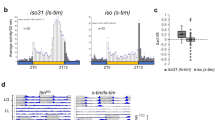Summary
In ‘constant’ conditions, individuals of the polychaeteTyposyllis prolifera stolonize up to 18 times each at circalunar intervals (mean ∼31 days). The endogenous mechanism driving this reproduction rhythm exhibits the characteristics of a true ‘circa’-oscillator (circalunar clock):
-
1.
Entrainment of cyclic sexual development (and ultimately stolonial swarming) to the lunar cycle has been demonstrated both in the field and in experimental conditions. Animals in a natural population tend to reproduce synchronously during the 2nd quarter phase of the moon. In asynchronous laboratory populations, ‘moonlight’ zeitgeber programs (some successive ‘moonlit’ nights every 30 days) cause entrainment, provided that the zeitgeber signals exceed a critical length (between 2 and 4 days). Above this value, the length of zeitgeber stimuli does not affect the quality of entrainment. The peaks of stolon abundance are phase-set by the cessation of nocturnal illumination (mean at 20 °C: 17.0 days after ‘moonoff’), independent of the length of the preceding ‘moonlit’ period. The temporal pattern of increasing entrainment in the course of repetitive stimulation permits a preliminary insight into the mechanism which causes adjustment of the clock.
-
2.
Within the range of 15 to 25 °C, the freerunning period is temperature-compensated (Q 10=1.04). However, coupling between oscillator and overt rhythm is restricted to the (cyclic) initiation of stolonization processes. Stolon release follows at a temperature dependent interval. Changes in temperature thus result in phase-shifts of the overt rhythm of stolon release.
-
3.
The oscillator runs essentially independent of the peripheral physiological processes involved in the manifestation of the reproduction rhythm (absence of feedback influences). Temperature and starvation influence the overt rhythm while the endogenous oscillator remains largely unaffected.
Similar content being viewed by others
References
Bünning E (1973) The physiological clock. Springer, Berlin Heidelberg New York
Bünning E, Müller D (1961) Wie messen Organismen lunare Zyklen? Z Naturforsch 16b:391–395
Fage L, Legendre R (1927) Pêches planctoniques à la lumière effectuées à Banyuls-sur-mer et à Concarneau. I. Annélides Polychètes. Arch Zool Exp Gén 67:23–222
Fox HM (1923) Lunar periodicity in reproduction. Proc R Soc London 95B:523–550
Franke HD (1980) Zur Determination der zeitlichen Verteilung von Fortpflanzungsprozessen in Laborkulturen des PolychaetenTyposyllis prolifera. Helgoländer Meeresunters 34:61–84
Franke HD (1983a) Endocrine mechanisms mediating light-temperature effects on male reproductive activity inTyposyllis prolifera (Polychaeta, Syllidae). Roux's Arch Dev Biol 192:95–102
Franke HD (1983b) Endocrine control of reproductive periodicity in maleTyposyllis prolifera (Polychaeta, Syllidae). Int J Invertebr Reprod 6:229–238
Hauenschild C (1955) Photoperiodizität als Ursache des von der Mondphase abhängigen Metamorphose-Rhythmus bei dem PolychaetenPlatynereis dumerilii. Z Naturforsch 10b:658–662
Hauenschild C (1960) Lunar periodicity. Cold Spring Harbor Symp Quant Biol 25:491–497
Hauenschild C (1961) Die Schwärmperiodizität vonPlatynereis dumerilii im DD/LD-Belichtungszyklus und nach Augenausschaltung. Z Naturforsch 16b:753–756
Korringa P (1947) Relations between the moon and periodicity in the breeding of marine animals. Ecol Monogr 17:347–381
Neumann D (1966) Die lunare und tägliche Schlüpfperiodik der MückeClunio: Steuerung und Abstimmung auf die Gezeitenperiodik. Z Vergl Physiol 53:1–61
Neumann D (1969) Die Kombination verschiedener endogener Rhythmen bei der zeitlichen Programmierung von Entwicklung und Verhalten. Oecologia (Berlin) 3:166–183
Neumann D (1981) Tidal and lunar rhythms. In: Aschoff J (ed) Biological rhythms. (Handbook of behavioral neurobiology, vol 4) Plenum Press, New York London, pp 351–380
Olive PJW, Clark RB (1978) Physiology of reproduction. In: Mill PJ (ed) Physiology of annelids. Academic Press, New York, pp 271–368
Pearse JS (1975) Lunar reproductive rhythms in sea urchins. A review. J Interdiscipl Cycle Res 6:47–52
Pittendrigh CS (1966) The circadian oscillation inDrosophila pseudoobscura pupae: A model for the photoperiodic clock. Z Pflanzenphysiol 54:275–307
Pittendrigh CS (1981) Circadian organisation and the photoperiodic phenomena. In: Follet BK, Follet DE (eds) Biological clocks in seasonal reproductive cycles. Wiley, Bristol, pp 1–35
Schroeder PC, Hermans CO (1975) Annelida Polychaeta. In: Giese AC, Pearse JS (eds) Reproduction of marine invertebrates, vol 3. Academic Press, New York, pp 1–213
Skopik SD, Pittendrigh CS (1967) Circadian systems II. The oscillation in the individualDrosophila pupa; its independence of developmental stage. Proc Natl Acad Sci USA 58:1862–1869
Spindler M, Hemleben C, Bayer U, Bé AWH, Anderson OR (1979) Lunar periodicity of reproduction in the planktonic foraminiferHastigerina pelagica. Mar Ecol Prog Ser 1:61–64
Author information
Authors and Affiliations
Rights and permissions
About this article
Cite this article
Franke, H.D. On a clocklike mechanism timing lunar-rhythmic reproduction inTyposyllis prolifera (Polychaeta). J. Comp. Physiol. 156, 553–561 (1985). https://doi.org/10.1007/BF00613979
Accepted:
Issue Date:
DOI: https://doi.org/10.1007/BF00613979




